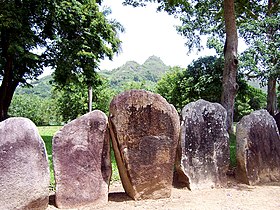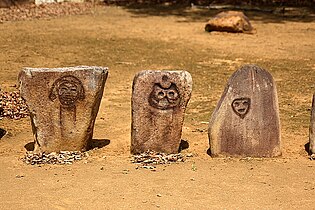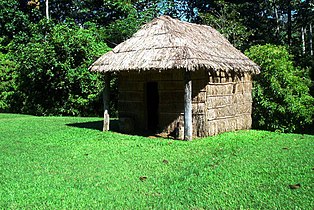Caguana Ceremonial Ball Courts Site
Overview
Approximately 13 ball courts and plazas (bateyes) have been identified and many have been restored to their original state. Monoliths and petroglyphs carved by the Taínos can be seen among the rocks and stones, some weighing over a ton, that were most likely brought from the Tanama River located adjacent to the site.
The site also contains the largest concentration of petroglyphs in the Antilles, most of which around found carved into the stone monoliths that form the bateyes or ball courts. Some of the most famous pictographs include a heron-like bird and atabeyra, also known as the "Caguana woman", attributed to the fertility zemi or goddess Atabey.
The plan of the site and the positions of the ball courts indicate an alignment with specific astronomical events, and the site might have functioned as a place to observe and possibly predict astronomical events such as planetary and stellar transits, conjunctions and alignments. Numerous of the petroglyphs depict astronomical objects such as the moon, stars and planets. Although the site is not listed as a world heritage site, its archaeoastronomical features are well-documented and recognized by the UNESCO Astronomy and World Heritage Initiative.
History
The site of the modern archaeological site was originally known as Corrales de los Indios (Spanish for "Indian corrals") by locals after the corral-like outlines of some of the ball courts. The first exploration and survey-works in the site were led by American anthropologist John Alden Mason in 1914. The site has been under continuous study since the 1930s, at first by archaeologists from Yale University such as Irvin Rouse, and later by the Institute of Puerto Rican Culture (ICP) and Dr. Ricardo Alegría. The ICP acquired the site in 1965 and invested in the restoration of its archaeological resources and on interpretative infrastructure for visitors. The interpretative park and a small museum were first opened to visitors that same year.
The museum remained closed from 2020 until june of 2024 when it reopened with a more thorough collection of more than 200 archaeological pieces. A digital version of the museum titled Museo Digital de Caguana was launched in 2024 by the Institute of Puerto Rican Culture.
Designations
The Institute of Puerto Rican Culture still manages the site as a park under the name Caguana Indigenous Ceremonial Center (Parque Ceremonial Indígena de Caguana). The National Park Service has placed it on the National Register of Historic Places, and designated it as a National Historic Landmark (under the name Caguana Site). It was listed on the National Register in 1992 and designated a U.S. National Historic Landmark in 1993. It was also listed on the Puerto Rico Register of Historic Sites and Zones in 2001.
The park also includes a small museum containing Taíno artifacts, archaeological exhibits and a small botanical garden featuring some of the plants the Taínos harvested for food such as sweet potatoes, cassava, corn, and yautía. Many of the trees used by the Taínos to construct their homes (bohíos), such as mahogany and ceiba can also be seen throughout the park.
Gallery
Scenes at Caguana Ceremonial Ball Courts Site:
-
Stones and mountain behind
-
Caguana Ceremonial Ball Courts Site
-
Ball Court
-
Bird drawn on stone
-
Faces drawn on stones
-
Traditional Bohio like the ones built by the Taino
See also
- List of United States National Historic Landmarks in United States commonwealths and territories, associated states, and foreign states
- National Register of Historic Places listings in central Puerto Rico
- Tibes Indigenous Ceremonial Center
References
- ^ "National Register Information System". National Register of Historic Places. National Park Service. April 15, 2008.
- ^ Mark R. Barnes (January 25, 1993). "National Historic Landmark Nomination: Caguana Ceremonial Ball Courts Site". National Park Service. and Accompanying four photos, from 1991
- ^ "Caguana Site". National Historic Landmark summary listing. National Park Service. Archived from the original on 2007-12-06. Retrieved 2007-06-28.
- ^ "Para la Naturaleza | Centro Ceremonial Indígena de Caguana con nueva aplicación móvil" (in European Spanish). Retrieved 2024-07-08.
- ^ "Caguana Ceremonial Ball Courts Site--Historic Places in Puerto Rico and the Virgin Islands; A National Register of Historic Places Travel Itinerary". www.nps.gov.
- ^ "Parque Ceremonial Caguana - Puerto Rico - Explorador - Ferries del Caribe". www.ferriesdelcaribe.com. Retrieved 2024-07-08.
- ^ "UNESCO Astronomy and World Heritage Webportal - Show entity". www3.astronomicalheritage.net. Retrieved 2021-11-29.
- ^ "Puerto Rico: misterios de sitio arqueológico en vía de descifrarse". EFE Noticias (in European Spanish). 2024-06-24. Retrieved 2024-07-08.
- ^ Rouse, Irving (1993). The Tainos: Rise and Decline of the People Who Greeted Columbus (New ed.). New Haven: Yale University Press. ISBN 978-0300056969.
- ^ Oliver, José R. (1998). El centro ceremonial de Caguana, Puerto Rico: Simbolismo iconográfico, cosmovisión y el poderío caciquil Taíno de Boriquén. ISBN 9780860549154.
- ^ ILAM, Fundacion. "Centro Ceremonial Indígena de Caguana". ilamdir.org (in Spanish). Retrieved 2024-07-08.
- ^ "Parque Ceremonial Indígena de Caguana. Puerto Rico". pueblosoriginarios.com. Retrieved 2021-11-29.
- ^ swissinfo.ch, S. W. I. (2024-06-04). "Inauguran valiosa muestra arqueológica que narra la historia prehispánica de Puerto Rico". SWI swissinfo.ch (in European Spanish). Retrieved 2024-07-08.
- ^ "Instituto de Cultura Puertorriqueña anuncia la renovación del Centro Ceremonial Indígena de Caguana". El Nuevo Día (in Spanish). 2023-10-06. Retrieved 2024-07-08.
- ^ GOBIERNO DE PUERTO RICO, JUNTA DE PLANIFICACIÓN DE PUERTO RICO (December 7, 2022). "REGISTRO DE PROPIEDADES DESIGNADAS POR LA JUNTA DE PLANIFICACIÓN DE PUERTO RICO" (PDF). jp.pr.gov.
External links
- National Park Service Images
- Additional National Park Service Images
- Centro Ceremonial Indígena de Caguana, Utuado - Puerto Rican Cultural Institute
- National Park Service site description for visitors Archived 2013-06-19 at the Wayback Machine
- National Historic Landmark description by the National Park Service
- Parque Ceremonial Indigena de Caguana Official Page
- Summary sheet from the Puerto Rico State Historic Preservation Office (in Spanish)







